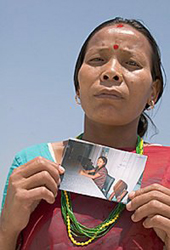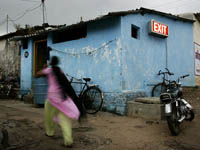Japan's Fight against Modern-Day Slavery (Part I)
Scott Hansen
Second Secretary, Political Section
U.S. Embassy Tokyo
Introduction

During three years of riding the ferry back and forth between Kochi City and Osaka while serving as a JET Programme English teacher, I never gave much thought to the large groups of Filipina women that were always on the ferry. They were always young and pretty, and usually in the company of one or two male escorts. I imagined that they worked in hostess bars, maybe they were prostitutes, but either way, I assumed that they were well-paid for work that they were doing voluntarily.
I discovered that my assumption was incorrect one day when upon arriving in Osaka, a noisy fight erupted between the women and their escorts. The bus into the city from the port was crowded, and one of the women sat down next to me. When I asked her if anything was wrong, she told me that the man had forgotten to bring their passports. "Why would that man have their passports?" I wondered, and I asked her what she was doing in Japan. For the rest of the bus ride, she told me a horrible tale of having been tricked into coming to Japan, the violent abuse that she suffered under her employer, and the repeated sexual assault that she was subjected to by customers.
As the bus was pulling into the airport, she shouted "Goodbye Japan, Hello Philippines!" in a very loud voice. Many of the Japanese passengers in the bus turned their heads to scowl at this culturally inappropriate gesture, and I was struck by how different my life in Japan was than this woman's. How lucky for me to be so completely in love with this country, to be consistently treated well by the Japanese, to not have to worry about whether I would be paid for my work, or to have to be afraid of getting hurt or raped.
 |
A Nepalese mother searches for her daughter, the victim of human trafficking, in Mumbai, India. (Kay Chernush for the U.S. State Department) |
That bus ride highlighted the very wide gap between what I had assumed about foreign women coming to Japan and the reality of those women's lives. I had experienced my first brush with trafficking in persons, one of humanity's most heinous crimes, a crime that unfortunately is growing all over the world.
As the U.S. Embassy Political Officer in charge of monitoring human trafficking in Japan, in this article I would like to briefly describe the problem of human trafficking and offer some suggestions for ways in which Japan might benefit from policy reform. Before beginning a discussion of trafficking in persons in Japan, it is important to acknowledge that the United States also faces a growing problem. No country is immune to the ravages of human trafficking. Although the United States has what are widely considered to be "best practice" anti-TIP policies and aggressively implements those policies, trafficking in persons appears to be a growing domestic crime. The sheer size of the United States, with its long, porous borders, makes it especially difficult to prevent the flow of potential victims into the country. The scale of the United States combined with the heterogeneous nature of its population also makes it easier for traffickers to hide their activities from authorities.
What is Trafficking in Persons?
Simply put, Trafficking in Persons is the removal of a person's freedom for economic benefit. The word "trafficking" can be misleading, as it suggests the movement of a person from one place to another. It is important to understand that a person does not have to be transported to have become a victim of trafficking in persons. For example, a woman can be trafficked in her own village, or even in her own house. If a man forces his daughter to prostitute herself and keeps the earnings, then his daughter is a victim of trafficking in persons without ever having left her house. Alternatively, even if a man has been working in a factory under reasonable conditions for three months, if his passport is suddenly taken away and his paycheck deposited for him in an employer-controlled bank account to which he does not have access, he has become a victim of human trafficking.
People unfamiliar with human trafficking often mistake human smuggling for trafficking in persons. There are several important differences. The biggest difference is freedom. Although persons who are being smuggled may be subjected to harsh and dangerous conditions during the transportation phase, they are free to go once they reach their destination. People who are being smuggled do it by choice. People who are trafficked have no choice. Another difference is that the crime of human smuggling ends once the destination is reached. The crime of trafficking in persons does not end, as the victims go on to be exploited until they become free from their circumstances. In summary, human smuggling is a crime against the state. Human trafficking is a crime against the victim.
Although they are different, human smuggling and human trafficking often co-exist. A meaningful example of this commonality is the U.S.-Mexico border. Hundreds of thousands of persons have been smuggled across this border, persons that are extremely vulnerable upon arrival to the United States. Traffickers, in some cases the smugglers themselves, might kidnap someone who has paid to be smuggled and force him or her to work in a factory or as a housekeeper or prostitute. In this case, someone who voluntarily elected to be smuggled becomes an involuntary victim of human trafficking.
It is easy to imagine that traffickers lock their victims up, incarcerating them like prisoners. Cases like that do occur, especially in the developing world. They make headlines when brothels burn down and victims who were chained to their beds are unable to escape, perishing in the flames. But there are many ways for a human being to control another without having to resort to ropes or chains.
One obvious method that traffickers use to control victims is violence - not just violence against the victims, but also threats of violence against the victims' families. In today's globalized society, traffickers in a destination country can directly contact the brokers or recruiters in the victims' home countries, meaning that threats against family members are very real. Another common method is document removal. Traffickers regularly remove passports and IDs from victims. Not knowing that new passports can be obtained from home-country embassies or consulates, victims believe they must obey their employers if they ever want to go home. Traffickers also use debt bondage to control victims. Upon arrival at the workplace, victims are often suddenly told that they have large debts. They are told that this debt will follow them anywhere in the world. Although their earnings theoretically reduce the debt, expenses like rent, medical bills, condoms, and food bills all add to it, trapping victims in an endless cycle. Victims have no way of knowing whether the debt repayment is being calculated fairly. There are no receipts for their payments; traffickers are aware that receipts can be used as evidence in court. Some women spend years paying off debts to their brokers. Some victims never get out of debt at all.
Traffickers also use devious psychological methods to coerce victims into submission. The most blatant example is a broker telling victims that if they go to the police, they will be arrested, beaten, and deported. Victims unfamiliar with a local country have no way of knowing that the stories are fabricated. Without the ability to speak the local language, and stripped of their documentation, they become terrified of leaving their traffickers. In Japan, TIP activists who work with victims also report that some clubs wait three months before informing the women that they must sell sex to continue their employment. Because they do not receive their wages until the end of the six-month stay, most women choose to stick it out and prostitute themselves rather than lose three months of investment. Even in hostess clubs that do not provide sexual services, punishing women who do not meet quotas compels them psychologically to sleep with clients in order to persuade them to become regular customers.
 |
Victims of human trafficking forced into prostitution (Kay Chernush for the U.S. State Department) |
Trafficking victims are subject to violence, coercion, rape, and exploitation. In addition to suffering devastating psychological trauma, sex-trafficking victims are often left with serious injuries and/or infected with HIV/AIDS. According to the World Congress Against Commercial Sexual Exploitation of Children, between "50 and 90 percent of children rescued from brothels in Southeast Asia are infected with HIV." Victims of labor trafficking also do not escape unscathed, often suffering from post-traumatic stress disorder, depression, gastrointestinal problems, back pain, and neurological problems. Trafficking in persons is not only a crime against the victims, it is a crime against humanity.
Trafficking human beings is an extremely lucrative crime. In contrast to selling drugs or stealing, which provide a one-time benefit, victims of trafficking can be exploited over and over until they are destroyed. Because of this, a trafficked human being is worth many times his or her weight in narcotics. There is much discussion about the degree to which organized crime is involved in international trafficking networks. Although it is impossible to generalize, it is likewise impossible not to notice that the real estate underneath the establishments exploiting human trafficking victims is often owned by crime syndicates. Even when organized crime groups are not directly involved, the fact that sex business owners almost always have to pay "protection" fees to these organizations often comes to light when a brothel owner is interrogated by police.

|
This 9-year-old girl in India works from morning to night seven days a week, as she and her family were sold to a block-maker. (Kay Chernush for the U.S. State Department) |
Although U.S.- government- sponsored research completed in 2006 estimated that approximately 800,000 people are trafficked across national boundaries each year, it is notoriously difficult to measure the extent of human trafficking. The International Labor Organization estimates that there are 12.3 million people in forced labor of some form at any one time. There is great debate over the massive gap between the estimated scope of human trafficking and the number of victims identified by law enforcement authorities. What is clear is that more research is needed. Whatever its extent, human trafficking is a crime so cruel in its nature, so brutal and inhumane, that it is a moral imperative that all the countries of the world unite to oppose it.
Human Trafficking in Japan
Japan is a destination and transit country for men, women, and children trafficked for commercial sexual exploitation. Victims come from China, Korea, Southeast Asia, Eastern Europe, and to a lesser extent Latin America. There are also increasing reports of internal trafficking of Japanese girls for sexual exploitation.
Brokers in the countries of origin recruit women and sell them to intermediaries or employers, who in turn subject them to debt bondage and coercion. Most women trafficked into Japan's sex trade have their travel documents taken away and their movements strictly controlled by their employers. Victims are threatened with reprisals to themselves or their families if they try to escape. Employers often isolate the women, subject them to constant surveillance, and use violence to punish them for disobedience. In some cases brokers use drugs to subjugate victims.
Women trafficked to Japan are usually employed as prostitutes under coercive conditions in businesses licensed to provide commercial sex services. Sex entertainment businesses in Japan include "store form" businesses, such as strip clubs, sex shops, hostess bars, and private video rooms, as well as "non-store form" businesses, such as escort services and mail order video services, which arrange for sexual services to be conducted elsewhere. The vast majority of women who have been trafficked into Japan for the purpose of sexual exploitation have been employed as hostesses in "snack" bars and are required to provide sexual services off premises. Although "snack" bars remain ubiquitous, many of the traditional brothels have closed. In response to increased police enforcement of the Law on Control and Improvement of Amusement Businesses, many sex business operators have shifted from store-front businesses to "delivery" escort services. This has made it much harder to measure the extent to which employers in Japan's massive sex industry are exploiting victims of trafficking.
Debt bondage is the most common method of controlling victims in Japan. Before arrival in the country, trafficking victims rarely understand the size of the debts they will owe, the amount of time it will take them to repay the debts, or the conditions of employment to which they will be subjected upon arrival. Women typically face debts upon commencement of their contracts of between $26,000 and $43,000 (3 million to 5 million yen). In addition, they have to pay their employer for their living expenses, medical care (when provided by the employer), and other necessities. "Fines" for "misbehavior" are added to the original debt over time, and the process that the employers use to calculate these debts is not transparent. Employers also sometimes "resell," or threaten to resell, troublesome women or women found to be HIV positive, thereby increasing the victims' debts and often leading to even worse working conditions.
Japan works actively to prevent human trafficking. Changes in visa requirements over the last few years have significantly reduced the number of women entering Japan as "entertainers." By requiring applicants to prove that they have two years of experience in the industry, obligating sponsoring organizations to pay a higher salary, and placing a heavier burden on Japanese clubs to prove their legitimacy, the government has reduced the number of Filipinas entering Japan as entertainers from more than 7,000 per month in 2004 to around 1,000 per month today. (This number still seems high. In contrast, the United States over the course of an entire year only issues a combined 13,000 "entertainer" visas to citizens from around the world.)
To raise awareness about human trafficking inside Japan, the Ministry of Foreign Affairs and the National Police Agency have produced tens of thousands of glossy brochures and pamphlets in the past year that describe the trauma caused by trafficking-in-persons, report what the government is doing to combat trafficking, and explain how a victim can find assistance. To build international cooperation, Japan has held bilateral meetings with 11 source countries, including the Philippines, Indonesia, and Thailand. As part of the Japan-Thailand Joint Task Force on Counter TIP, a Japanese Immigration Officer has been in Bangkok training Thai officials to recognize fraudulent Japanese documents. According to Japanese consular officials, few Thais enter Japan on entertainer visas; most victims have entered the country using fraudulent documents. The Japanese government's claim that the Bangkok immigration officer training program is helping to keep Thai women out of the sex trade may be true; private shelter operators say that the number of Thai women working in brothels and clubs in Japan appears to have decreased significantly over the last few years.
Police and immigration officers use the Ministry of Health, Labor, and Welfare's (MHLW) network of shelters (Women's Consulting Centers or WCCs) as temporary housing for foreign trafficking victims awaiting repatriation. The government pays for victims' medical care and subsidizes their repatriation through a grant to the International Organization for Migration (IOM). Originally established by the Anti-Prostitution Law as facilities to provide services and care to Japanese-nationality prostitutes, the shelters are now used primarily to protect victims of domestic violence, and lack the resources needed to provide adequate services to trafficking victims.
Japan's prosecution of trafficking offenders has significantly improved during the last year. In 2006, 78 trafficking suspects were arrested, 17 cases prosecuted, and 15 trafficking offenders convicted under the 2005 statute. This is a significant increase from the few prosecutions and one conviction obtained in 2005. Of the 15 convictions in 2006, 12 offenders received prison sentences ranging from one to seven years; three offenders received suspended sentences.
Although Japan's trafficking problem is centered on sex trafficking, labor trafficking may be a growing problem. Labor rights activists and the media increasingly carry reports of abusive company practices. In some companies, foreigners are forced to work unpaid overtime and make less than the minimum wage. Furthermore, their wages are automatically deposited in company controlled accounts, despite the fact that "forced deposits" are illegal. In addition, laborers sometimes have their travel documents taken from them and their movement controlled to "prevent escape."
Japan and the TIP Report
In 2000 the United States Congress passed the Trafficking Victims Protection Act (TVPA). The TVPA defined the three P's of anti-human-trafficking policy: Prevention (of human trafficking), Protection (and rehabilitation of victims), and Prosecution (of traffickers following a vigorous investigation). Besides establishing programs for fighting human trafficking in the United States, the TVPA also mandates that the Department of State annually measure, evaluate, and report on foreign governments' efforts to eliminate severe forms of trafficking in persons. Each year, the authors of the Trafficking in Persons Report compare the prevention, protection, and prosecution policies and the implementation of those policies in each country with the "minimum standards" as defined by the TVPA, and give that country a "grade." Tier 1 countries are countries whose policies and implementation meet the minimum standards. Tier 2 countries are those countries whose policies and implementation fail to meet the minimum standards, but the governments are making significant efforts to improve. Tier 3 is reserved for those countries that do not make any significant efforts to meet the minimum standards as defined by the TVPA. There is another category, the Tier 2 Watch List, which consists of countries that are in danger of falling to Tier 3.
Any discussion of human trafficking in Japan must begin with an acknowledgment of the fantastic improvements that the government has made over the last three years. After having received a Tier 2 ranking in the 2003 Report, Japan was put on the Tier 2 Watch List in the 2004 Report. Over the next two years, the Japanese government took a number of steps that improved Japan's overall anti-trafficking efforts. That same year, Japan established an anti-TIP interagency task force that developed an Action Plan to fight human trafficking. In 2005 the Diet passed an anti-trafficking law and revised the Law on Amusement Businesses to crack down on employers of undocumented workers. Combined with the revisions to "entertainer" visa regulations mentioned above, as well as many other programs, these efforts merited an upgrade to Tier 2 in 2005. Although these significant efforts have been sustained over the last two years, they still fall short of compliance with the minimum standards as set forth in the Trafficking Victims Protection Act. In the next issue of American View, I will discuss some of the areas that Japan will need to address in order to receive a Tier 1 ranking in the TIP Report.
Continue to Part II, Spring edition of American View
|
Scott Hansen, a Second Secretary in the Political Section of the U.S. Embassy in Japan, covers human trafficking, crime, religious freedom, refugees, and human rights. He also follows Japan’s relations with Central and South America, the Caribbean, Africa, Europe, and international organizations. He previously served at the U.S. Consulate in Chiang Mai, Thailand. Before joining the State Department in 2003, Scott taught English in the JET Program in Kochi City, Japan. Scott has a bachelor’s degree in Economics from the University of Michigan in Ann Arbor. Originally from Colorado, he has experience in search and rescue operations and wilderness survival. Scott spends every free moment with his wife Maggie Flynn and their two-year-old son Lucas. |
|
MTV EXIT Campaign
The MTV EXIT campaign, funded in part by the U.S. Agency for International Development, raises awareness of human trafficking through a documentary, short films, online information, and special events. Traffic: An MTV EXIT Special tells the stories of real people who unwittingly became part of the trafficking chain, including Anna from the Philippines who was forced into prostitution; Eka, an Indonesian woman trafficked into forced domestic servitude and a life of slavery; and Min Aung from Burma, who was trafficked to Thailand and imprisoned for two years in a factory. The documentary gives insight into the realities of trafficking, emphasizes that everyone plays a role in the issue, and provides information on how individuals can protect themselves against trafficking, as well as what people can do to help end exploitation and trafficking. Well-known celebrities, including VERBAL (m-flo) in Japan, pop icon Rain in Korea, Tata Young in Thailand, and others, present local-language versions of the documentary throughout Asia. American actress Lucy Liu presented an English-language version in Singapore and Malaysia. "Human trafficking has become a critical human rights issue facing young people across Asia and the Pacific. Victims are subject to horrendous abuses, including rape and torture, with women and girls particularly affected," said Bill Roedy, Vice Chairman, MTV Networks. "Law enforcement and community-level efforts to stop human trafficking have been hampered by the public's lack of awareness about the severity of this problem," said Olivier Carduner, USAID's Regional Mission Director for Asia. "Raising awareness will encourage communities to promote the law enforcement and victim outreach efforts needed to stop this atrocious crime." MTV EXIT programming is rights-free and free of charge for all broadcasters and organisations. For Japanese material, see www.mtvjapan.com/special/exit/. |

